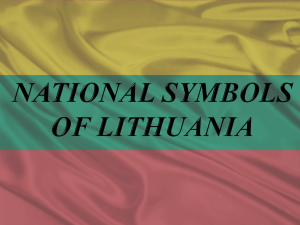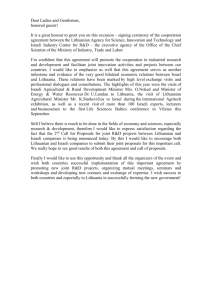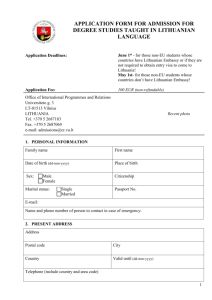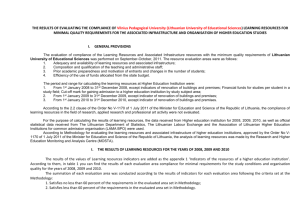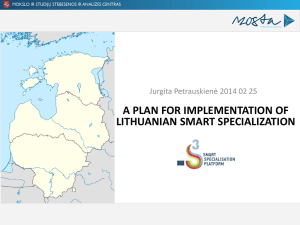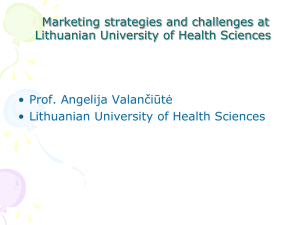Turinys - Lietuvių kalbos institutas
advertisement
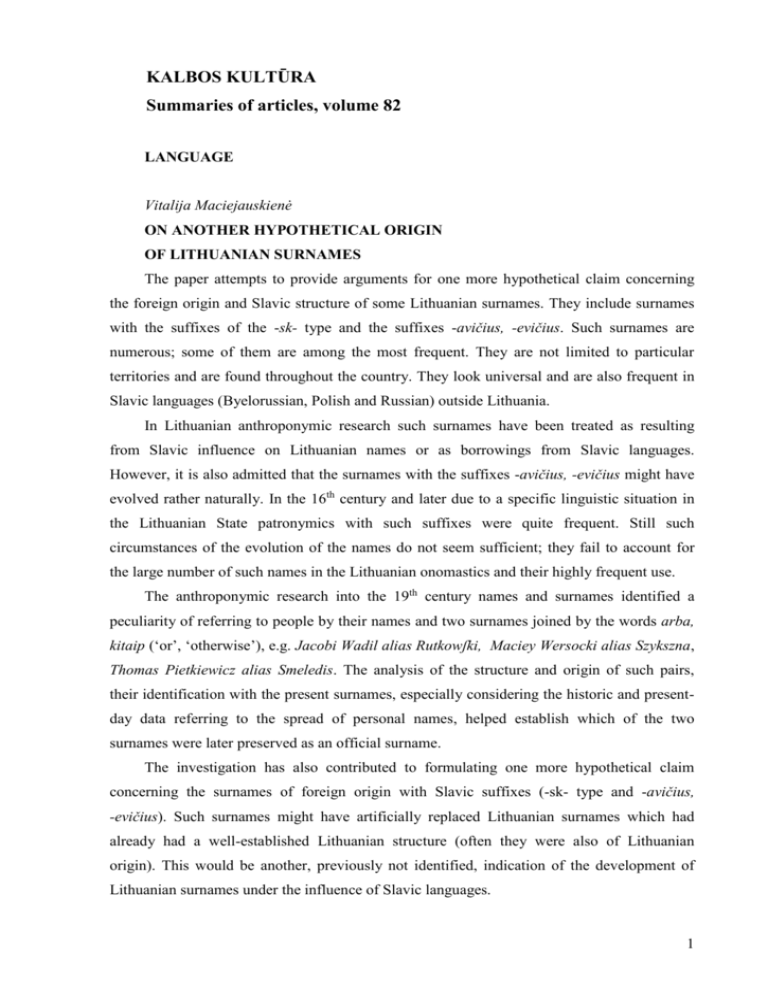
KALBOS KULTŪRA Summaries of articles, volume 82 LANGUAGE Vitalija Maciejauskienė ON ANOTHER HYPOTHETICAL ORIGIN OF LITHUANIAN SURNAMES The paper attempts to provide arguments for one more hypothetical claim concerning the foreign origin and Slavic structure of some Lithuanian surnames. They include surnames with the suffixes of the -sk- type and the suffixes -avičius, -evičius. Such surnames are numerous; some of them are among the most frequent. They are not limited to particular territories and are found throughout the country. They look universal and are also frequent in Slavic languages (Byelorussian, Polish and Russian) outside Lithuania. In Lithuanian anthroponymic research such surnames have been treated as resulting from Slavic influence on Lithuanian names or as borrowings from Slavic languages. However, it is also admitted that the surnames with the suffixes -avičius, -evičius might have evolved rather naturally. In the 16th century and later due to a specific linguistic situation in the Lithuanian State patronymics with such suffixes were quite frequent. Still such circumstances of the evolution of the names do not seem sufficient; they fail to account for the large number of such names in the Lithuanian onomastics and their highly frequent use. The anthroponymic research into the 19th century names and surnames identified a peculiarity of referring to people by their names and two surnames joined by the words arba, kitaip (‘or’, ‘otherwise’), e.g. Jacobi Wadil alias Rutkowʃki, Maciey Wersocki alias Szykszna, Thomas Pietkiewicz alias Smeledis. The analysis of the structure and origin of such pairs, their identification with the present surnames, especially considering the historic and presentday data referring to the spread of personal names, helped establish which of the two surnames were later preserved as an official surname. The investigation has also contributed to formulating one more hypothetical claim concerning the surnames of foreign origin with Slavic suffixes (-sk- type and -avičius, -evičius). Such surnames might have artificially replaced Lithuanian surnames which had already had a well-established Lithuanian structure (often they were also of Lithuanian origin). This would be another, previously not identified, indication of the development of Lithuanian surnames under the influence of Slavic languages. 1 Pranas Kniūkšta WHERE HAS THE SURNAME KNIŪKŠTA COME FROM? The Dictionary of Lithuanian Surnames (Lietuvių pavardžių žodynas) suggests that the surname Kniūkštà should be related to the adjective kniūkštas and is comparable to the surname Kniūpštà made from the adjective kniūbsčias. Older sources suggest that Kniūkšta might have originated from Kniūpšta. The Salantai church book of the 17th century does not have a single entry for Kniūkšta; however, it has a patronymic Kniūpštaitis from the village of Barzdžiai, which might indirectly refer to Kniūpšta residing in the same village. The surname Kniūpšta was preserved until the beginning of the 19th century; its last entry was found in the last decade of the 18th century in the birth register of the church book of Kalnalis. The surname Kniūkšta was recorded in the census of Salantai parish in 1853. However, it had not a single Kniūpšta; the latter surname also disappeared from the villages previously mentioned in the church book of Kalnalis. This might suggest that Kniūkšta was not a new surname but rather made from Kniūpšta. In Salantai parish in the 19th century the surname Kniūpšta was most frequent in three villages: Barzdžiai, Erlėnai and Juodupėnai. In the middle of the 20th century it was mostly found in a small area of Lowlanders (žemaičių) between Salantai, Kretinga, Kuliai and Plungė; in the 20th century the surname spread to the west of Lithuania and major cities of the country. Marija Razmukaitė ON SOME SUFFIXED OIKONYMS OF WESTERN LITHUANIA The paper offers an overview of pluralia tantum oikonyms spread in Western Lithuania and derived from personal names with the help of the diminutive suffixes -alis, -ytis, -ikas, ikis, -ulis, -uitis, -uižis, -utis, -užis. These are derivatives with the structural elements -aliai, yčiai, -ikai, -ikiai, -uliai, -uičiai, -uižiai, -učiai, -užiai. The oikonyms have been collected , Skuõdas, Kretingà Plùngė, Telšia Lowlanders (žemaičių) and Jùrbarkas, Jõniškis and Šiauli , or the area of Western Highlanders (aukštaičių). The results of the investigation are rather tentative. Rasuolė Vladarskienė ON THE STRUCTURE OF TITLES OF REPORTS 2 The paper discusses prepositional phrases used in the titles of reports in the context of present-day tendencies of usage and provides recommendations. Publications offering recommendations give reference to the genitive case as a major means of expressing the object of report. Thus, report titles should first of all include genitival constructions. Prepositional phrases could be used if the genitival construction is unsuitable for semantic reasons. The phrase ataskaita dėl (‘report on’) can be used when the statistical data is given together with its analysis, reasons for the problematic situation, difficulties, predicted outcomes and other issues related to the existing situation. The phrase ataskaita apie (‘report about/on’) can be used when other means of expression (like the genitival construction or the phrase ataskaita dėl) are unsuitable for semantic reasons, are ambiguous or when the position of the genitive is already taken. Vincentas Drotvinas YOU CANNOT DELETE A WORD IN AN IDIOM The paper deals with Lithuanian idioms containing lexical borrowings. Idioms in which Lithuanian words replace borrowings give rise to doublets. To maintain the stability of idioms, borrowings should not be replaced with Lithuanian words. Aušra Rimkutė STANDARDISING RELIGIOUS TERMS IN PASTOR JUOZAS LAUKAITIS’S CATECHISM MINOR FOR CHILDREN At the beginning of the 20th century Juozas Laukaitis (1873 – 1952) was among those outstanding figures who cherished the Lithuanian church language and who was very much concerned about standardising Lithuanian religious terms. He was chair of the so-called Prayer Commission and one of the first to take care of the language of prayers and to promote their Lithuanian version. The paper aims at discussing the terms and their evolution in the three editions (1904, 1907 and 1914) of J. Laukaitis’s Catechism Minor for Children (Mažasis katekizmas vaikeliams). The paper also aims at identifying principles and criteria of standardising religious terms, evaluating amendments made in catechisms published almost one hundred years ago in reference to standard Lithuanian. From the three editions of the Catechism there were about 600 different one-stem (almost one third of all terms) and compound religious terms, their synonyms and variants collected. All editions contained some Lithuanian religious terms, e.g. Dievas (‘God’), duona 3 (‘bread’), dvasia (‘spirit’), Kraujas (‘blood’), Kūnas (‘body’), našlė (‘widow’), Sūnus (‘son’), vanduo (‘water’), velnias (‘devil’), žaltys (‘grass-snake’) etc., some borrowed terms which had no equivalents at the time or their foreign origin might have been overlooked, e.g. almužna (‘alms’), aniolas (‘angel’), arkaniolas (‘archangel’), čysčius (‘purgatory’), čystata (‘chastity’), dūšia (‘soul’), grabas (‘coffin’), griešnas (‘sinful’), karunka (‘canticle’), pakūta (‘repentance’), šliūbas (‘wedding’), veselija (‘marriage’) etc. Most terms were used synonymously, e.g. auka – apiera (‘offering’), išpažintis – spaviednis (‘confession’), nusidėjimas or nuodėmė – griekas (‘sin’), bausmė – kora (‘punishment’), malonė – mylista (‘mercy’), mirtis – smertis (death’), paslaptis – tajemnyčia (‘secret’), pragaras – pekla (‘hell’), pasaulis – svietas (‘world’), teismas – sūdas (‘trial’), viltis – nodieja (‘hope’) etc. (preference was usually given to the Lithuanian term). The standardisation of religious terms by J. Laukaitis could be treated as the most general approach to standardising the terms of the field. Spelling and syntactic varieties of the terms as well as their synonyms found in the three editions of the Catechism Minor for Children suggest that religious terms were still rather inconsistent. Artūras Judžentis ON REASON CLAUSES WITH THE CONJUNCTION JOG The conjunction jog connects reason clauses frequently used in old Lithuanian writings as well as in present-day publicist, belles-lettres and free style Lithuanian; however, new descriptive, standardising and pedagogical grammars fail to mention them. The paper deals with older and modern usage of the above clauses, offers an overview of their research and development of codification. The paper suggests that the above clauses should be treated as appropriate for standard Lithuanian; arguments for the claim are provided. Jolanta Zabarskaitė INTERJECTIONS IN LANGUAGE AND SPEECH Interjections make up a part of speech which is much more complex and varied than it looks at first sight. Without limiting to their formal structure and considering similar or equivalent functions and usage, the part of speech might include more linguistic phenomena than are usually attributed to interjections in traditional grammars. In dialects interjections are not so numerous. They are mostly used in re/telling a story, i.e. in telling about the past, in fairy-tales etc. Research into the usage of interjections, their motivation and expression of national identity could promote their more frequent usage. This is particularly relevant today, when we 4 can witness the evolvement of the language of information technologies. To identify the position of interjections in the system of language, to clearly define their role in the lexicon, to include them in dictionaries and define in the databases and annotated corpora, further detailed and consistent research into their usage would be indispensable. Such research could also contribute to ethno-linguistic investigation. Loreta Vaicekauskienė POST-MODERN BILINGUALISM: NATIONAL LANGUAGES AND ENGLISH IN ADVERTISING The paper offers an overview of research into advertising and shows that code-switching and code-mixing with English on the world market is gradually becoming a norm. The pressure is so firm that possible violations of the requirements of official, pure and wellformed language or even changing the understanding of language acceptable for public use do not seem to pose any threat. Nowadays it is becoming more and more difficult to account for the ongoing changes using such concepts of modern discourse as “protection against the domain loss”; rather, reference should be made to the framework of the criticism of post-modern perception of reality that linguistic reality tends to change together with the changing cultural identity. Presently, the identity of a language user should not be related merely with ethnic, territorial or national boundaries: English has become accessible to all and some social groups use it as a resource and as a means of expression. It is such identity of a plurilingual user and the freedom of his/her choice to use as many codes as necessary that can help explain why most domains, including advertising, are becoming mixed. In the texts focusing on language policy and standardising the Lithuanian language such opportunities have never been discussed. Regina Koženiauskienė THE ROLE OF COLLOQUIAL AND JARGON WORDS IN PUBLIC JOURNALISTIC DISCOURSE The paper discusses colloquial and jargon words used by a famous journalist in political commentaries. It also attempts to identify functions of dispreferred words in public discourse and whether and to what extent they are compatible with standard Lithuanian usage and the ethics of journalists. The author is usually able to distance himself from colloquial and jargon words; he speaks like a stranger, from aside, and gives references to well-known political figures by using elements of their speech (e. g. blin, dzin, išdūrė, tūpas, vsio zakonno). He also adds 5 some such words and expressions of his own accord, e. g.: otkatininkai, krūtas, mafiozų šestiorka, keturių banda, apmauti, susimauti, perspjauti, užkalti, vagilka and some other pejorative words and phrases referring to limited intellectual ability of politicians, e.g.: svaičioti, vapėti, nuo bėgių nušokęs plumprotis, nebrendyla, debiliškai, kietakaktiškai. The journalist’s lexicon also contains some vivid idioms, like dėti skersą, kabinti makaronus, duoti stogą or colloquial expressions: į cypę įkišti, aplink pirštą apvynioti, špyga taukuota. The journalist admits that in many cases a vivid word or expression is more relevant than a serious political argument. However, the paper focuses on the evaluation of the behaviour and individual actions of politicians expressed by colloquial and jargon words and phrases rather than their vividness or stylistic function. The paper expresses doubts as to the ethical aspects of such vocabulary and its morally negative impact on the society. Giedrius Tamaševičius LANGUAGE SIMPLIFICATION TENDENCIES IN PUBLIC SPACE During the last years on numerous occasions it has been claimed that language used in public space in Lithuania undergoes simplification. Journalists and politicians make numerous language and style errors, since they lack language competence and understanding of language norms. However, so far language specialists have failed to discuss reasons, why politicians and political analysts, who generally have a good command of the Lithuanian language, suddenly turn to spoken and colloquial style whenever exposed to public view. In linguistic literature this is explained by the theory of sociolinguistic accommodation investigating ways of adjusting to the audience and the term of jargonisation defining the impact of social transformation on the language. The privatisation of public space exerts influence on the language of mass-media and politicians; a tendency towards colloquialisation has been noticed. The language of public life has been very little researched so far; thus the above claims could only be proved or disproved after a thorough investigation into the public spoken language of journalists and politicians. LANGUAGE AND SOCIETY Rita Miliūnaitė ATTITUDES OF INTERNET COMMENTATORS 6 TOWARDS THE SUPERVISION OF THE LITHUANIAN LANGUAGE The paper deals with the attitudes of internet commentators towards the supervision of the Lithuanian language. Reference is made to a discussion launched on the internet in April 2009 on the initiative of the Commission of the State Lithuanian Language that the new draft law on the state Lithuanian language should include a provision that the language of the information placed on the internet and public space in general should be in accordance with the requirements of standard Lithuanian. The researched commentaries have shown that people differ in their attitudes towards the importance of language supervision and control of different areas of language usage. Some claim that any intrusion into language is unacceptable; others admit that some areas of language usage should be controlled on a national level. The majority of commentary writers are not indifferent towards the processes going on in contemporary Lithuanian and current language policy; they also raise various issues on language supervision and expect that language supervision institutions should be more actively involved in the process. The commentaries usually refer to the following areas of language usage (official and free) which require supervision and control (given in the order of importance): 1) mass media (television and radio programmes, TV films, news portals on the web and the press); 2) public discourse of politicians (language of politicians and other representatives of public institutions); 3) public information and services (public notices, names of companies, company websites); 4) education (kindergartens and schools); 5) literature (especially translations); 6) private websites (e.g. blogs) and internet commentaries. The society most often relates its expectations of a well-formed and grammatically correct language with spoken, printed and internet mass media. The public information (public notices, names of companies) and the language of politicians are treated as requiring most control. The supervision of public speeches on the internet, not included in the Law on State Lithuanian Language of 1995, is treated in different ways. Many people approve of the idea that the language of news portals should be more strictly supervised. However, opinions differ as to the supervision of commentaries and particularly their regulation by fines. Some agree that stricter control should be imposed on the language of commentaries, especially spelling and swear words; some authors treat such measures as an attack on human rights. 7 Before taking measures of language policy and discussing them in public, it would be important to consider the variety of approaches and their arguments. This would help avoid misunderstandings and the tension arising between linguists and the society at large. Laima Nevinskaitė THREATS TO LANGUAGE AND LANGUAGE SUPERVISION: A JOURNALISTIC APPROACH The paper analyses the attitude of journalists as a group of language users towards threats to language and a need to supervise it. The object of investigation has been chosen due to the fact that threats to language are often given as grounds for language policy. The analysis of the guidelines of the state language policy in Lithuania has shown that insecurity about the preservation of language and identity is given as an important aspect of the situation in language policy. Within the project Baltic Sociolinguistics (BalSoc): linguistic awareness and orientation in Lithuania and Latvia (Institute of the Lithuanian Language, supported by the Lithuanian State Science and Studies Foundation) there were 23 interviews with journalists collected. Most journalists are of the opinion that language is not exposed to any threats since the present situation has resulted from the natural language development, any evils are a matter of fashion and tend to pass, the preservation of language is more related to the preservation of the nation rather than language change; some consider the tough language regulation as a major threat. Some journalists tend to partially support language supervision; however, the majority of them are in favour of a different approach to it. Current language policy is mostly criticised for inappropriate measures: the respondents would prefer an educational approach, more attractive forms to the existing control. The language policy, according to them, should be more flexible and more usage-oriented. Summarising the approaches of the respondents to the above issues, there has been a remarkable consistency noticed: those who see threats to language also, at least partially, approve of its supervision; those who disprove of its supervision do not see any threats. A large group of the respondents in favour of the language supervision have pointed out that they do not see threats. Therefore, the awareness of language threats works as a factor for language supervision; on the other hand, the approval of language supervision is not necessarily based solely on the threats. Such conclusions might be relevant for discussing language policy in target groups. The conclusions are indicative that to encourage language 8 users to support the currently implemented language policy, the (sole) factor of threats and language security is insufficient. Linda Lauze FUNCTIONS AND SPHERES OF USE OF LATVIAN LANGUAGE VARIETIES: RADIO AND TELEVISION JOURNALISTS’ OPINION The aim of the present paper is to characterize those functions and spheres of Latvian language variety uses that can be inferred from interviews with radio and television journalists. The recorded interviews on which the study is based were done with 24 Latvian radio and television journalists as well as programme leaders. It is part of the results of the project Baltic Sociolinguistics (BalSoc): Linguistic Awareness and Orientation in Lithuania and Latvia (project leader Dr. Loreta Vaicekauskiene) submitted to the Lithuanian State Science and Studies Foundation by the Institute of the Lithuanian Language. The face-to-face standardized interviews (length – 883 min) consisted of 20 questions about the following issues: language features, language prestige, journalists’ linguistic and communicative competence, language policy and language situation in Latvia as well as data about the respondents and programmes hosted by them. The sample was 24 male, 32–48 year old representatives of both national and commercial audio-visual media. After long discussions and preliminary research during the project we consider representatives of this social group being typical radio and television journalists and programme leaders. The present paper deals with radio and television journalists’ opinion about functions and spheres of use of the literary language, colloquial speech, slang and sub-dialects not only in audio-visual media but also in other areas of life. In the interviews, speaking about Latvian language varieties journalists and programme leaders also expressed their opinions referring to several important language functions, namely, the communicative, referential, phatic, emotive, appellative and esthetic function. We should note that there was no direct question about language functions in the interviews. Though colloquial speech has considerable impact on language use in public space, the interview results show that the position of the Latvian literary language is sound. The interviewed representatives of audio-visual media do not speak about all language functions 9 reflected in journalese however they are aware of the main functions and the spheres of use of all Latvian language varieties. In further research it would be necessary to analyze the speech behavior of the respondents while developing broadcasts on radio or television. Anda Blūmane COMPETITION BETWEEN PLURAL AND SINGULAR FORMS OF ADDRESS IN PUBLIC SPOKEN USAGE The address plays a significant role in the communication of every person. Likewise, the communication between students, teachers and the school administration is unimaginable without using different address forms. Their successful choice influences further communication and mutual understanding. The school as the environment for research is interesting because this is a place where ancient language traditions merge with innovations. The research is based on a questionnaire responded to by 718 students, 125 teachers and 48 school principals. The majority of the surveyed students (562) live in cities and towns, only 153 live in the country. The students’ questionnaires were divided into two groups according to their age: 10–14 and 15–19. When analyzing ways and models of addressing, it is necessary to define what the address in sociolinguistics means. The term address forms is used in a wider sense in sociolinguistics than in traditional grammar. By it sociolinguists understand not only a noun in vocative, but also the pronominal address and word combinations with a person’s title, first name or surname. In Latvian course-books on linguistics the address model is mainly connected with a noun or a word used in the sense of a noun. This differs from the address model used by the greatest part of society in everyday oral communication. Traditional grammar does not deal with the modifications of nicknames, first names or surnames or the pronominal address forms tu, jūs (thou, you). In grammar analysis the address system is a limited body of familiar variants. The body of address variants dealt with in sociolinguistics differs from the one dealt with in school grammar books. The alternative approach includes the role of social factors in the choice of modes of addressing, which vary depending on age, gender, status and other factors. Both interdependence and the lack of it, symmetry or asymmetry are important criteria for analyzing the address in communication. Address forms in school between students and teachers are mainly formal which is determined by the etiquette norms accepted in society (tu, 10 jūs relations, skolotāj (teacher)+ surname and similar forms). In the communication among students, and in their communication with teachers there may be informal deviations. For the greatest part in the school nominal and pronominal address forms are used, like the first name, a nickname, an associative nickname which is a phonetic modification of the first name or surname, a contracted form of the first name or surname, the use of the surname alone (which is a very popular address form among 15– 19 year olds), the use of the first name and patronymic, a diminutive form of the first name and surname, an address inversion (meit, dēls (daughter, son)), combined address forms – an interjection+ the address, kolēģīt+ Tu (colleague + thou), kolēģīt+ Jūs (you), draugs (friend)+ tu, Jūs+ first name, skolotāj(teacher)+ first name, skolotāj+ surname, direktor (principal)+ surname, direktor+ first name and others. The choice of the address forms used by young people is freer and open to the influence of other cultures. In the communication between teachers and students the address forms used are for the greater part asymmetric expressing distance and respect towards the teacher. The usage of symmetric forms in the communication between a student, a teacher and the school principal point to the teachers’ openness to new tendencies in the language and education. Correlation rules are realized both on the vertical and the horizontal level. The vertical level becomes apparent in the operation of the principles of power, the horizontal one – in cooperative ties. The vertical dimension realizes itself between a student and a teacher, a student and the school principal, a teacher and the principal, the horizontal dimension – between a student and a student, a teacher and a teacher. The address model existing between a student and a teacher is mainly asymmetric. With students growing up, the use of reciprocally symmetric forms grows, too. 19% of the surveyed students address their teachers using their first name or the address form consisting of the word skolotāj (teacher) + the first name. Asymmetric address forms exist between younger and older colleagues. Mainly asymmetric address forms exist between a teacher and the school principal. Teachers address their principal by address forms like Jūs, first name, Tu, whereas principals address teachers by their first name, jūs, tu. Jurgita Girčienė COMPETITION BETWEEN PLURAL AND SINGULAR FORMS OF ADDRESS IN PUBLIC SPOKEN USAGE A quantitative analysis of television talk shows representing public usage and broadcasted between 26 January 2009 and 11 March 2009 has identified a marked preference 11 for the polite form of address, which is usual in this area of usage: different addressors referred to 248 different addressees by the polite plural form jūs and only to 43 different addressees by the less polite singular tu. A qualitative analysis has identified differences between programmes dealing with public issues (PPI) and programmes focusing on entertainment and/or personal issues (PEI). PPIs are related to public official usage and therefore consistently use plural forms of address which help maintain social distance. PEI, in their turn, are mostly related to freer public usage, hence singular forms of address which help maintain friendly relationships compete with plural forms of address. Both of them are equally popular (jūs found in 57 instances; tu—in 42 instances). A different character of PPIs and PEIs determines differences in the choice of their participants and in addition to the previously discussed aspects of official and free usage might also influence the choice of the forms of address. The main socio-linguistic factors determining the choice of the forms of address in PPIs include the age of the addressor and the addressee, closeness between them, social roles which might be influenced by education and social status. The plural form in PPIs is mostly used when addressing older, more respectable participants, often performing the roles of decision takers or experts. The singular form is preferred by moderators, used in reference to peers, younger interlocutors or acquaintances. It should be noted that PPI moderators attempting to combine public and private sometimes have to cope with rather tough situations, for example, by linguistic means, including polite forms of address, they have to create a friendly environment and show respect to their guests and the audience. Loreta Vaicekauskienė, Vaida Švežaitė LANGUAGE ERRORS AND LINGUISTIC SELF-CONFIDENCE: A SOCIOLINGUISTIC RESEARCH INTO LINGUISTIC ATTITUDES The paper introduces the results of a research conducted in 2009 and based on questionnaires collected from 200 respondents of lower than higher education (secondary and specialised) in the age group of 18-60 years. The respondents were from three major cities of Lithuania and their neighbourhood: Vilnius, Kaunas and Šiauliai. The investigation was aimed at identifying how the concept of well-formed language and how correcting language errors influenced the respondents’ linguistic self-confidence. Differently from traditional studies focusing on the norm, the present investigation presupposes that for ordinary language users, well-formed language is not confined to grammatically correct language and that linguistic self-confidence should be determined by other factors not limited to the knowledge of language rules. 12 The results of the investigation have shown that the representatives of the above social group give a fairly high evaluation to their own language skills, especially speaking, and a well-formed language for them is fluent, free language which might be grammatically acceptable but could also be ungrammatical. At the same time, it can be seen that linguistic self-confidence might be reduced by language errors which are corrected: the respondents whose language was corrected in situations with an asymmetric distribution of power (e.g. the corrections were made by teachers), expressed less positive attitudes towards their own skills. The conclusion is supported by preliminary data obtained from television and radio journalists of Lithuania. Ala Lichačiova THE CONCEPT OF NATIVE LANGUAGE FROM THE POINT OF VIEW OF RUSSIANS OF LITHUANIA AND NATIVE SPEAKERS OF RUSSIAN The paper discusses definitions of the concept native language and different national concepts of the notion concerned with one’s mother tongue as well as its ambiguity arising in different research areas. The paper also includes some responses and reflections on a native language provided by Russian language speakers of Lithuania; the data has been extracted from the survey recently conducted in Lithuania. These reflections could be treated as naïve definitions of the above notion. Further in the paper, the key factors determining the respondents’ definitions of the native language are given. The spreading binary character of the category is also taken into consideration: more frequently, alongside one native language (of an early, pre-school period of life), there emerges another language (other than the one spoken at home, language of instruction), which is closely related to human cognition. The latter language becomes an individual’s second native language. The results of the survey have shown that the opposition between ‘own’ and ‘other’ language often characteristic of a homogenous monolingual society in the understanding of Russian speakers of Lithuania is replaced by two equally important ‘own’ halves. Daiva Aliūkaitė, Erika Merkytė A SOCIOLINGUISTIC INVESTIGATION OF GRAMMATICAL WELL-FORMEDNESS OF DIALECTAL CODES The concept of grammatical well-formedness is concerned with standard language. Dialects are spontaneous systems, they show the development of a language and usage peculiarities. Any dialect might adopt elements from foreign systems; however, they do not 13 become ungrammatical. It can thus be claimed that the criterion of grammatical wellformedness is in principle unsuitable for dialects. However, the experience of researchers from other countries has shown that evaluating dialectal codes in terms of grammatical wellformedness in the framework of perceptive dialectology is usual practice. The present investigation focuses on the grammatical well-formedness of dialectal codes. Considering the data of perceptive research, the paper aims at defining the wellformedness of dialectal codes from the user’s/receiver’s (evaluator’s) point of view rather than the researcher’s. The concluding remarks on the well-formedness of dialectal codes are based on a research conducted in October-December of 2008 in the districts of Kaunas and Šakiai and focusing on the perception and evaluation of dialectal speech by school-students in their 9-12 year at school (aged 14-18). The research materials covered a corpus of 6 textstimuli and a questionnaire; both were prepared in accordance with the requirements of perceptive dialectology. To conclude, young respondents adhere to a certain prototype of a well-formed expression. For them, well-formedness is primarily concerned with standard language. However, in this context a natural question could arise: is well-formedness related with the school students’ actual experience or confined to the knowledge received at school that language is a well-formed system and that it serves (or can serve) as a reference to evaluate another expression? Since dialects are usually discussed in the framework of general requirements applicable to standard language, they are usually treated as ungrammatical rather than grammatical. A major factor determining the well-formedness of the dialectal code is its affinity to standard language: the more similar the dialectal code is to standard language, the more grammatical it is. Young respondents consider the well-formedness as a major factor of communicative success: if the text is difficult to understand, it is also more or less ungrammatical. Differing evaluation of the dialectal codes of Highlanders (aukštaičių) and Lowlanders (žemaičių) provides basis for further research that dialectal codes of Highlanders are treated as more grammatical than Lowlanders. Gintarė Žalkauskaitė LITHUANIAN CHARACTERS IN ELECTRONIC MAIL The paper introduces the results of a survey on using Lithuanian characters in electronic mail. They have helped define the existing situation, attitudes of educated people (who have 14 completed higher education studies or their major part) towards (not) writing Lithuanian characters in electronic mail. Habits of writing Lithuanian characters vary. As can be seen from the survey results, for most people (not) writing Lithuanian characters in their electronic mail depends on the nature of the letter, the addressee and computer programmes. The main reasons for not writing Lithuanian characters so far have been still concerned with technical problems and insufficient information provided to the society on computers and the internet. Thus responsible institutions ought to give more attention to this issue. The respondents have also expressed rather contradictory attitudes towards using Lithuanian characters on the internet. Most adhere to the opinion that writing without Lithuanian characters does not cause difficulties in text comprehension; however, many respondents have expressed rather negative attitudes to such writing and pointed out its negative impact on literacy and language. DISCUSSION Laima Kalėdienė PUBLIC OPINION AND LANGUAGE POLICY The paper sets out to examine if the present language policy responds to the society’s needs. A conclusion is made that presently Lithuania has no general policy of all languages used in the country; it only has a certain attitude formed towards the state Lithuanian language and legal basis established for the state Lithuanian language. Any other language can adopt some parts of the laws or decrees of the Government. As shown by the results of a representative sociolinguistic research Language usage and national identity in the cities and towns of Lithuania (Cities and languages), the situation does not respond to the needs of the society and the changing life. Presently, issues of using and teaching English are of special importance. A search for a better job determines that the society manifests an increased need to learn English; however, there is neither adequate plan of measures to be implemented nor resources; there are no qualified specialists either. The society’s request that bilingual learning/teaching should be started at secondary schools has been rather unexpected. Ineta Dabašinskienė, Raminta Garuckaitė EARLY FOREIGN LANGUAGE ACQUISITION: OPEN QUESTIONS 15 Social and economic changes exert influence on the language of children and adults as well as its development. A deteriorating language urges to seek reasons and raise new questions: when and how children should start learning a foreign language, which factors should be taken into consideration to achieve better results, and what impact a foreign language has on one’s native tongue. Most apprehensions on early foreign language teaching/learning are concerned with its negative influence on one’s mother tongue. In Lithuania there has been hardly any research done; research conducted in other countries has not confirmed any of the apprehensions. The negative impact on one’s native language can only be discussed in reference to the language loss and deterioration noticed in the language of immigrant groups who have lived in a foreign country for a longer time. On the other hand, there are numerous advantages of the early language teaching/learning: acquisition of values, development of tolerance and culture, acquisition of general skills concerned with cognition and thinking, memory and attention. The research has shown that foreign language learners tend to acquire more linguistic competences than those who only know their native language. It is important that the advantage is also seen in the better results of the native language learning, for example, in the usage of complex sentences or better reading skills. Moreover, a positive effect in the opposite direction has also been noticed when one’s mother tongue helps develop foreign language competences, since there appears a possibility to compare two different language systems. Studies of foreign researchers help find answers to all questions raised in the paper, because in Lithuania there is an obvious gap in the research on early language acquisition. Specialists of Vytautas Magnus University together with their colleagues from Croatia and Italy are currently working on a project aimed at filling in the gap and possibly providing answers to the key questions in the area. Stefano M. Lanza ON THREE BORROWINGS FROM ITALIAN CUISINE The paper discusses three Italian borrowings which have recently become very popular in Lithuania; they refer to the dishes calzone, carpaccio and tiramisù. On the basis of onomasiologic research and the criteria adopted for standardising borrowings, each of the above borrowings is analysed from several points of view: language history, semantics, morphological structure, usage and relation with the Lithuanian language system. When adapting the borrowing, it should be decided which is better: a morphologically and phonetically adapted (to Lithuanian) unit or a Lithuanian lexical unit. It is generally held that to refer to foreign realia, the adapted variant is more suitable than the native equivalent. 16 Moreover, the words like calzone, carpaccio and tiramisu usually spread in language like borrowings, and the users take efforts to grammatically adapt them (however, a large variety of forms has been noticed). When the actual usage does not violate the rules of the language system, it should be supported. After the analysis of each of the three words, the following forms have been suggested for use: kalcònė (2nd accentuation pattern, feminine gender), karpãčio (uninflected, masculine gender) and tiramisù (uninflected, masculine gender). 17
